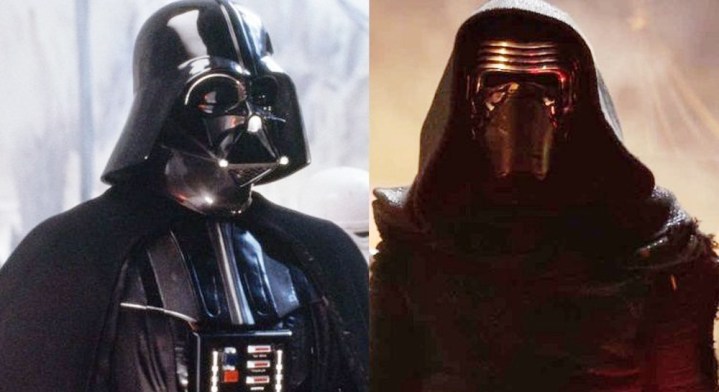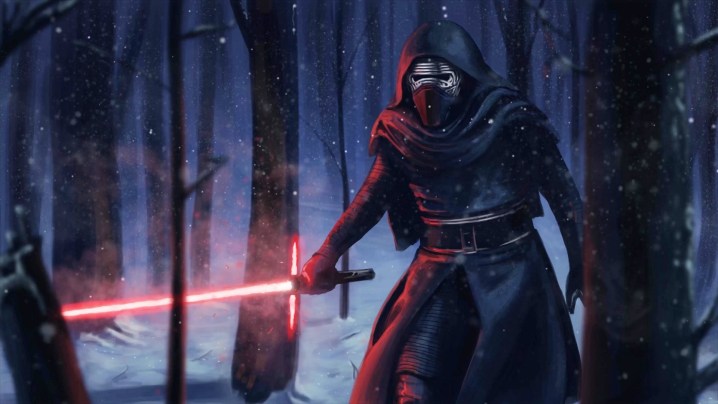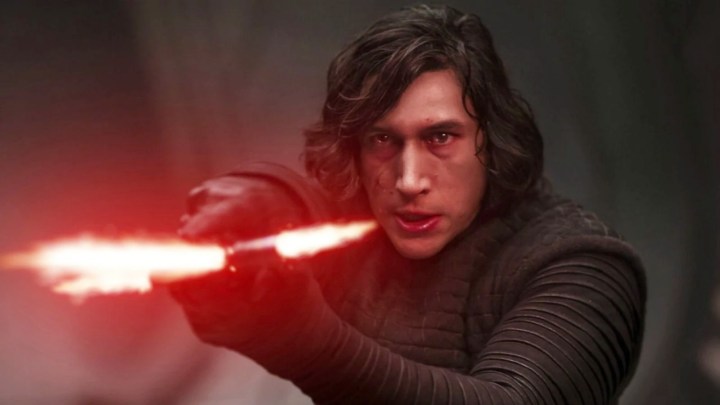
Star Wars eras are defined as much by their villains as by their heroes. While Emperor Sheev Palpatine is the overarching evil mastermind behind the entire Skywalker Saga, he’s never truly been the face of the franchise. That honor falls to the grim reaper of the galaxy, Darth Vader. His intimidating stature (provided by bodybuilder David Prowse), booming voice (courtesy of James Earl Jones), and menacing helmet (designed by Ralph McQuarrie and sculpted by Brian Muir) have made him an immortal pop culture icon.
But what about his successor from the Star Wars Sequel Trilogy, Kylo Ren (Adam Driver)? Positioned as the new hotness among merciless enforcers of space fascism, it seems the man once called Ben Solo never really got his due as a top-shelf villain in cinema’s most inescapable franchise. With the Skywalker Saga now years in our rearview, it’s time to reevaluate the question: Who is the better character, Darth Vader or Kylo Ren?
Darth Vader is unquestionably cooler than Kylo Ren

Judging by pure cool factor, there are precious few villains in cinematic history who can contend with the OG Sith Lord himself, Darth Vader. We’re talking about a figure so imposing and confident that he makes wearing a respirator look rad as hell. He’s outer space’s greatest movie monster, an unstoppable half-human menace whose powers are limited only by the available special effects. Vader is so superficially awe-inspiring that we have to remind ourselves occasionally that this guy is a mass murderer and that gushing about him to this extent is probably a bad look. (RIP to those younglings, Remember Alderaan, et cetera.) Our point is that, since 1977, Darth Vader has been the standard by which all other Big Bads are measured. He is the postmodern Dracula.
So, naturally, his grandson, Kylo Ren (aka Ben Solo), had some huge boots to fill when he debuted in Star Wars: The Force Awakens in 2015. Everything about Kylo Ren’s Sith Lord persona is derivative of his famous forbearer, from the black helmet whose shape implies a pained grimace, to his cape, to his distorted voice. Just as the First Order is essentially a Galactic Empire cover band, Kylo Ren is a Darth Vader impersonator. Sick crossguard lightsaber notwithstanding, that makes the last of the Knights of Ren less cool, by definition.
However, that doesn’t make him a worse character. Quite the contrary — Kylo Ren being a pale imitation of Darth Vader is precisely what makes him an interesting antagonist.
Kylo Ren’s inadequacy is what makes him a great villain

The most common knock by fans and critics against The Force Awakens is that it’s less of a follow-up to Return of the Jedi or a new beginning for Star Wars as a whole than it is a remake of A New Hope. Reverence for the original Star Wars seeps through every pore of J.J. Abrams’ reboot, but it’s hard to deny that it feels a bit like a Greatest Hits album. That may not do any favors for the new heroic trio Rey, Finn, and Poe, but in the case of the new film’s villain, the fact that Kylo Ren cannot escape being viewed as “the new Darth Vader” is actually built into the text.
Rey may be a fan of Luke Skywalker and Han Solo, but she isn’t hung up on being the galaxy’s next great hero. Kylo Ren, on the other hand, has plainly modeled himself after his grandfather and attempted to claim his legacy, but it’s not working out for him. The Darth Vader we see in A New Hope and The Empire Strikes Back (and, to a lesser extent, Return of the Jedi) is irrepressible and self-possessed. To fail Darth Vader is to invite death, and the act of killing you won’t even raise his heart rate. In The Force Awakens, Kylo Ren aches to exert this kind of authority, but he doesn’t have it in him. When things don’t go his way, he vents his frustration by trashing equipment with a lightsaber, a display of bluster with no real consequences. It takes murdering his father, Han Solo, to give him the confidence to go full-bore evil, and that confidence dissolves mere minutes later when untrained Jedi potential Rey fights him to a stalemate.
This allows us to spend the following film, The Last Jedi, watching Ben Solo complete his transformation into Kylo Ren. Humiliated by his failure at Starkiller Base, Kylo Ren doubles down on his violence and aggression in a desperate attempt to prove that he can be taken seriously. He steps out of Vader’s shadow, smashing his off-brand helmet, blasting his dear mother Leia Organa into open space, and slaying his master, Snoke. He no longer has any illusions about becoming the stoic, faceless enforcer of the new Empire. He becomes his own man, a rageful tyrant who will burn the galaxy down if it suits him. Being “the next Vader” no longer interests him; He wants to be the first Kylo Ren, a new kind of terror who is easier to provoke but harder to predict. This is a more interesting journey than Vader — or his alter ego of Anakin Skywalker — travels throughout the entire saga.
Darth Vader and Kylo Ren’s arcs are both incomplete on screen

Unfortunately, due to the uneven quality of Star Wars media, neither Darth Vader nor Kylo Ren receives complete and coherent character arcs in their big-screen appearances. Despite dedicating a full six hours to Anakin Skywalker’s fall from grace, the Star Wars Prequel Trilogy fumbles by depicting Anakin as an unstable hard case far too early, making his transformation from Jedi prodigy to Sith executioner feel inevitable rather than tragic.
It’s only in the animated midquel series, Star Wars: The Clone Wars, that Anakin Skywalker comes across as a hero or a friend, and even this can’t totally smooth out Anakin’s erratic arc from the films. Vader’s eventual redemption in Return of the Jedi also feels relatively sudden, particularly now that the character’s journey is so spread out across decades of media, but his actions and motives in the Original Trilogy get fleshed out significantly in the 2015 Darth Vader comics series, which reveals Vader’s secret efforts to undermine Palpatine throughout their partnership.
Likewise, Ben Solo casting off the mantle of Kylo Ren and redeeming himself via heroic sacrifice in The Rise of Skywalker feels less like a progression of his character and more of a contrivance to return him to the station or “Vader Lite.” Just as Vader turned against Palpatine to save his son, Ben Solo turns on a dime after the death of his mother and gives his life to rescue Luke’s successor, Rey. (Ben and Rey share a kiss before his death despite the fact that they’re sort of cousins, which is actually very typical Skywalker behavior.)

Further, recasting Kylo Ren’s mentor Snoke as a mere puppet for a revived Emperor Palpatine, who has been “every voice [Ben Solo] ever heard inside his head,” robs Ben of what little agency he has in his own story, as well as the opportunity to become something new, more akin to Palpatine himself than to Vader. Had Ben/Kylo’s story been permitted to remain a pure tragedy about an insecure child of privilege becoming irretrievably seduced by fascism, it might have allowed him to make a stronger final impression.
As it stands, it’s hard to argue that Kylo Ren is the superior character, but it’s a shame that the storytellers’ decision to maintain the “rhyming stanza” structure of the Skywalker Saga undermined any possibility of Kylo Ren becoming an iconic villain in his own right.
Winner: Darth Vader (but Kylo Ren more than holds his own).
You can stream Star Wars movies, shows, and specials on Disney+.
Editors’ Recommendations
Services Marketplace – Listings, Bookings & Reviews
